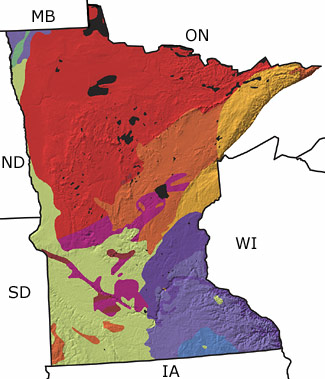Paleontology and geologyThe Precambrian: Precambrian rocks in Minnesota provide evidence of the early formation of the North American continent, as well as the presence of an ocean covering this part of the world. Both stromatolites and unusual sedimentary layers called banded iron formations formed in the sea by the activity of bacteria and both are common in the state’s Precambrian rocks. Fossils are typically primitive, one-celled organisms.
The Paleozoic: The Early Paleozoic is well represented in Minnesota. The North American continent was located much closer to the equator during much of the Paleozoic, and the climate was tropical. Sea level rose during the Early Paleozoic, flooding much of southern Minnesota. This sea left behind records of a sandy coastline and shallow marine habitats. These deposits contain evidence of life dominated by marine invertebrates, including trilobites, brachiopods, and strange, shelled organisms called hyolithids. This shallow, tropical sea continued to cover most of southern Minnesota during the Ordovician, and at times may have flooded the entire state. Skeletons of marine organisms accumulated as sediments on the sea floor; these sediments eventually became limestone and dolostone. Stromatolites and microbial mats dominated the sea early in this period, but were succeeded by bryozoans, brachiopods, crinoids, and molluscs later in the Ordovician. The Silurian was a time of widespread exposure of the continent, and erosion has removed any Silurian rocks and fossils that might have been deposited. A shallow sea again flooded southern Minnesota during the Devonian. Limestones formed from limy sediments deposited on the sea floor contain abundant fossils of brachiopods, cephalopods, trilobites, and corals.
The Late Paleozoic and Mesozoic: In Minnesota, there are no Late Paleozoic (Carboniferous and Permian) or Early Mesozoic (Triassic) rocks found, and very little is known about the Jurassic. The only sedimentary rocks from the Jurassic are deeply buried, but they record evidence of an eastward extension of a shallow sea into northwestern Minnesota. There are no known fossils in these rocks. During the Cretaceous, a northeastern extension of the sea intermittently covered much of Minnesota. Oysters, clams, and other typical marine organisms inhabited the shallow sea floor and ammonites and sawfish swam in the waters above. The climate was much warmer than today, and dense, tropical vegetation flourished on land across the state.
The Cenozoic: The Cenozoic is represented in Minnesota only by Quaternary deposits that reveal the alternating advance and retreat of glaciers. Mastodons, mammoths, musk ox, and other large mammals roamed the Quaternary landscape. |

